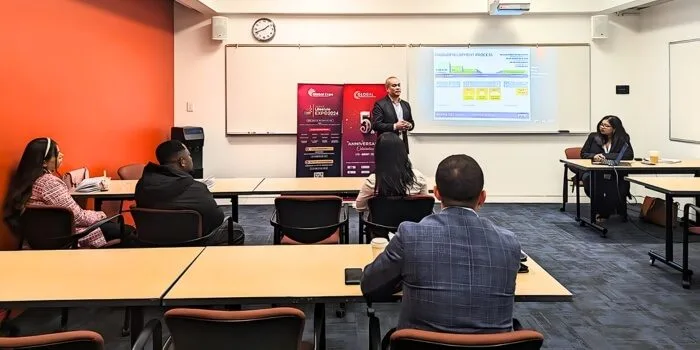Conferences, spanning academic, industry, and professional spheres, serve as vital forums for knowledge exchange and networking. Amidst the diverse array of conferences, a common query resounds: “Why do conferences have such short page limits?” This inquiry lies at the heart of my upcoming paper, exploring the rationale behind page constraints in various conference settings.
Across academic, industry, and professional conferences, the issue of page limits of 10-12 pages emerges as a ubiquitous challenge. From scholarly research dissemination to practical case studies and technological advancements, understanding the motivations driving these limitations unveils the intricate dynamics shaping conference proceedings.
Let’s into the reasons behind page constraints in conferences of all types. Join us on an exploration of the nuances influencing scholarly exchange, industry innovation, and professional discourse within diverse conference settings.
Understand Conference Dynamics
Conference dynamics encompass a complex interplay of factors shaping the experience and outcomes of these gatherings. From academic symposiums to industry expos, conferences serve as hubs for knowledge exchange, networking, and professional development. Each type of conference brings its unique atmosphere and objectives to the table, catering to diverse audiences and interests.

In academic conferences, scholars convene to present their latest research findings, engage in scholarly discourse, and forge collaborations. These events often feature paper presentations, poster sessions, and panel discussions, fostering intellectual exchange and advancing disciplinary knowledge.
Attendees range from seasoned academics to graduate students, all seeking to contribute to their fields and stay abreast of the latest developments.
Industry conferences, on the other hand, are geared towards professionals within specific sectors, such as technology, healthcare, or finance. These gatherings provide platforms for companies to showcase their products, demonstrate innovations, and network with potential clients and partners.
Attendees come from various backgrounds, including business executives, entrepreneurs, and industry experts, united by a shared interest in advancing their industries and exploring new opportunities.
Why Do Conferences Have Such Short Page Limits?
Conferences have short page limits of 10-12 pages to keep the time short for reviewers. It is the most specific answer for: Why do conferences have such short page limits?
However, whether you’re a seasoned academic or a budding researcher, understanding the reasons behind these constraints can help you navigate conference submissions more effectively.
Ensuring Concise Presentations
Short page limits encourage authors to distill their research into its most essential components, fostering clarity and conciseness in presentations. This ensures that conference sessions remain focused and engaging, maximizing the impact of each presentation within limited timeframes.
By prioritizing succinctness, conferences promote effective communication and knowledge dissemination among attendees.
Accommodating Numerous Speakers
With a plethora of speakers lined up for a conference, organizers face the challenge of accommodating everyone within a finite schedule. Short page limits allow for a higher number of presentations per session, ensuring that diverse topics and perspectives are represented. This inclusivity enriches the conference experience for attendees, exposing them to a wide range of research and ideas in a condensed format.
Facilitating Efficient Review Processes
Conference organizers and reviewers must evaluate numerous submissions within tight deadlines. Short page limits streamline the review process by reducing the volume of content to assess per submission. This enables reviewers to provide more thorough and timely feedback, enhancing the quality of accepted papers and ensuring a rigorous selection process.
Promoting Accessibility and Engagement
Short page limits make conference proceedings more accessible to a broader audience, including busy professionals and students with limited time. Attendees can quickly grasp the key insights and findings presented in each paper, facilitating meaningful discussions and interactions during conference sessions.
This accessibility fosters greater engagement and participation, enriching the overall conference experience for all involved.
Encouraging Effective Time Management
By imposing constraints on the length of presentations, conferences encourage presenters to prioritize their most significant findings and insights. This cultivates essential skills in time management and presentation planning, equipping researchers with valuable tools for communicating their work effectively in various professional settings.
Ultimately, short page limits empower presenters to deliver impactful presentations that resonate with their audience.
Making your way through the world of conference submissions can be daunting, but understanding the reasoning behind short page limits can help you approach the process with confidence. By embracing concise communication and effective time management, you can make the most of your conference presentations and contribute meaningfully to your field.
How to Write a Good Conference Paper?
Here are some valuable tips you should follow to write an engaging conference paper.
Step 1: Choose a Relevant Topic
Select a topic that aligns with the theme and focus of the conference, ensuring that your paper addresses current issues or gaps in the field. Conduct thorough research to identify recent developments, key findings, and emerging trends that warrant exploration in your paper.
Step 2: Structure Your Paper Effectively
Organize your paper into clear sections, including an introduction, literature review, methodology, results, discussion, and conclusion. Each section should flow logically and cohesively, guiding the reader through your research process and findings. Use headings and subheadings to enhance readability and facilitate navigation within your paper.
Step 3: Write Clear and Concise Content
Communicate your ideas succinctly and effectively, avoiding jargon and unnecessary technical details. Focus on conveying your key arguments and findings clearly and compellingly, using precise language and supporting evidence to strengthen your points. Pay attention to clarity, coherence, and cohesion in your writing to ensure that your paper is accessible to a wide audience.
Step 4: Provide Adequate Support and Citations
Support your arguments and claims with relevant literature, data, and examples from reputable sources. Cite your sources accurately and consistently, following the citation style specified by the conference guidelines. Incorporate quotes, paraphrases, and citations strategically to demonstrate the scholarly rigor and validity of your work.
Step 5: Revise and Edit Carefully
Take the time to revise and edit your paper thoroughly, paying attention to clarity, coherence, grammar, punctuation, and formatting. Seek feedback from colleagues, mentors, or peer reviewers to identify areas for improvement and refine your paper further. Proofread your final draft meticulously to ensure accuracy and polish before submitting it to the conference.
Careful planning, research, and attention to detail require writing a conference paper. But with perseverance and dedication, you can create a paper that makes a meaningful contribution to your field. By following these steps and incorporating feedback along the way, you can enhance the quality and impact of your conference submissions.
Frequently Asked Questions
Take a look at the similar FAQs related to the topic:
Can’t Longer Papers Provide More Comprehensive Information?
While longer papers may offer more detail, short page limits promote clarity, focus, and accessibility, enhancing the impact and effectiveness of conference presentations.
How Do Short Page Limits Affect Authors?
Short page limits challenge authors to prioritize their most significant findings and insights, fostering essential skills in concise communication and effective time management.
Do Conference Organizers Impose Page Limits Arbitrarily?
No, page limits are typically set based on conference objectives, format, and logistical considerations, aiming to balance inclusivity, quality, and efficiency in paper presentations.
Are There Exceptions to Page Limits for Certain Types of Conferences?
Some conferences may allow longer papers for specific presentation formats or special sessions, but generally, page limits apply across various conference settings to standardize submissions.
Do Page Limits Apply to Abstracts and Posters as Well?
Yes, page limits often extend to abstracts and posters, requiring authors to condense their research findings into summaries or visual representations for presentation at conferences.
How Can Authors Effectively Navigate Short Page Limits?
Authors can maximize the impact of their papers by focusing on their most significant contributions, organizing their content effectively, and using clear and concise language to convey their research findings.
Conclusion
It is imperative to comprehend the rationale behind the limitations on conference page size to effectively participate in the submission process. By recognizing the importance of concise communication, authors can craft papers that resonate with their audience and maximize the impact of their research.
While it may seem challenging to condense complex ideas into a limited space, embracing short page limits fosters clarity, focus, and accessibility in conference presentations. So the question “Why do conferences have such short page limits?” lies at the heart of conference dynamics, shaping the way researchers communicate and disseminate their findings.
By acknowledging the multifaceted reasons behind these constraints, authors can approach conference submissions with confidence, knowing that their efforts contribute to a vibrant and dynamic scholarly community.







